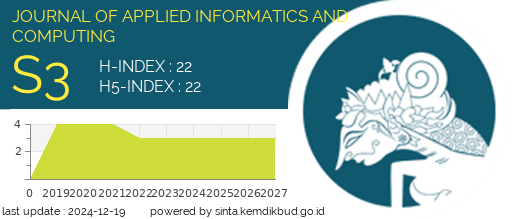The Role of Marketplaces in Assisting MSME Growth Using the Systematic Literature Review Method
DOI:
https://doi.org/10.30871/jaic.v9i2.8981Keywords:
Digitalization, Marketplace, MSMEs, Systematic Literature Review, TechnologyAbstract
Digital technology provides significant opportunities for Micro, Small, and Medium Enterprises (MSMEs) to grow and innovate, contributing to national economic growth. This study aims to analyze the role, impact, and supporting factors of marketplaces in fostering MSME development in Indonesia. Using the Systematic Literature Review (SLR) method, 103 journals were identified through Publish or Perish via Crossref for the 2019–2024 period. These journals were then filtered down to 40 journals selected for descriptive analysis. The 2019–2024 timeframe was chosen as it reflects a significant surge in marketplace adoption during the COVID-19 pandemic.The findings reveal that marketplaces significantly enhance MSMEs by increasing market reach by up to 40%, improving operational efficiency through a 30% reduction in order processing time, and building customer trust through reviews and ratings. The study also highlights the importance of supporting factors such as adequate digital infrastructure, digital literacy, and support from the government and platform providers. However, challenges such as limited internet access, low digital literacy, high commission fees, and intense competition with larger brands hinder the optimal use of marketplaces by MSMEs.This study recommends several practical solutions, including strengthening digital infrastructure, subsidizing internet costs, providing digital literacy training, and offering special promotion programs for small MSMEs. Although this study relies on secondary data, the findings provide relevant insights for policymakers, platform providers, and MSME actors. Further studies using primary data are needed to enhance the generalizability of these findings.
Downloads
References
[1] A. Ariani, R. S. Adabi, and S. A. Abhinaya, “Dampak Adanya E-Commerce terhadap Peningkatan Penjualan UMKM”.
[2] F. Fitriyana, A. Nuryani, T. Rosyati, and Y. Gusvia, “Pelatihan Pemanfaatan Marketplace Pada Umkm Dalam Masa Covid-19,” DEDIKASI PKM, vol. 2, no. 2. Universitas Pamulang, pp. 206–206, 2021. doi: 10.32493/dedikasipkm.v2i2.9765.
[3] Nahdah Iryani and T. Rachmat Fauzan, “jurnal bab 2 jenis marketplace Pemasaran Digital Melalui Fitur Live Pada Platform Marketplace Terhadap Pengembangan Bisnis,” J. Manaj., vol. 13, no. 2, pp. 121–139, Dec. 2023, doi: 10.30656/jm.v13i2.7693.
[4] Databoks, “E-Commerce dengan Pengunjung Terbanyak Sepanjang 2023 | Databoks.” Accessed: Oct. 20, 2024. [Online]. Available: https://databoks.katadata.co.id/teknologi-telekomunikasi/statistik/3c9132bd3836eff/5-e-commerce-dengan-pengunjung-terbanyak-sepanjang-2023
[5] J. Strauss, R. Frost, and N. Sinha, 4. E-marketing, 7. ed., Internat. ed. in Always learning. Boston Munich: Pearson, 2014.
[6] N. I. Watajdid, A. Lathifah, and D. S. Andini, “Systematic Literature Review: Peran Media Sosial Terhadap Perkembangan Digital Marketing”.
[7] B. Kitchenham, “Procedures for Performing Systematic Reviews”.
[8] G. Y. Elfira, “Dampak Penggunaan Media Sosial Dengan Metode Systematic Literatur Review”.
[9] E. Triandini, S. Jayanatha, A. Indrawan, G. Werla Putra, and B. Iswara, “Metode Systematic Literature Review untuk Identifikasi Platform dan Metode Pengembangan Sistem Informasi di Indonesia,” Indones. J. Inf. Syst., vol. 1, no. 2, p. 63, Feb. 2019, doi: 10.24002/ijis.v1i2.1916.
[10] J. P. Ginting, M. A. Nst, A. Fitri, S. Rizwinie, F. K. Sihotang, and A. Hidayatullah, “Analisis Dampak Dari Marketplace Terhadap Pertumbuhan Umkm Di Indonesia,” vol. 15, no. 1, 2020.
[11] S. Ardilla and N. H. Hadinata, “Sistem informasi marketplace produk usaha mikro kecil menengah (umkm),” J. Digit. Teknol. Inf., vol. 5, no. 2, p. 86, Sep. 2022, doi: 10.32502/digital.v5i2.4986.
[12] H. I. Juliantari, Z. Ariani, N. Y. S. Dewi, A. Agustina, and N. Hidayanti, “3. Analisis Pengaruh E-Commerce: Studi Literatur Terhadap Pertumbuhan Ekonomi UMKM,” vol. 4, 2024.
[13] S. Maya and A. P. Husda, “Pengaruh E-commerce, Pengetahuan Akuntansi dan Sistem Informasi Akuntansi Terhadap Kinerja UMKM,” ECo-Buss, vol. 6, no. 3, pp. 1178–1193, Apr. 2024, doi: 10.32877/eb.v6i3.1101.
[14] “Model pengembangan sistem waterfall, buat kasus apa yang tepat?,” Binus University Bekasi. Accessed: Nov. 24, 2024. [Online]. Available: https://binus.ac.id/bekasi/2024/08/model-pengembangan-sistem-waterfall-buat-kasus-apa-yang-tepat/
[15] S. A. Saputri, I. Berliana, I. Berliana, And M. F. Nasrida, “Peran Marketplace Dalam Meningkatkan Daya Saing Umkm Di Indonesia,” Knowledge: Jurnal Inovasi Hasil Penelitian dan Pengembangan, vol. 3, no. 1. Pusat Pengembangan Pendidikan dan Penelitian Indonesia, pp. 69–75, 2023. doi: 10.51878/knowledge.v3i1.2199.
Downloads
Published
How to Cite
Issue
Section
License
Copyright (c) 2025 Rizqi Kurnia Sari, Muhammad Adie Syaputra

This work is licensed under a Creative Commons Attribution-ShareAlike 4.0 International License.
Authors who publish with this journal agree to the following terms:
- Authors retain copyright and grant the journal right of first publication with the work simultaneously licensed under a Creative Commons Attribution License (Attribution-ShareAlike 4.0 International (CC BY-SA 4.0) ) that allows others to share the work with an acknowledgement of the work's authorship and initial publication in this journal.
- Authors are able to enter into separate, additional contractual arrangements for the non-exclusive distribution of the journal's published version of the work (e.g., post it to an institutional repository or publish it in a book), with an acknowledgement of its initial publication in this journal.
- Authors are permitted and encouraged to post their work online (e.g., in institutional repositories or on their website) prior to and during the submission process, as it can lead to productive exchanges, as well as earlier and greater citation of published work (See The Effect of Open Access).











